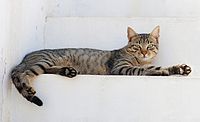
Photo from wikipedia
Tritrichomonas foetus isolates from feline and bovine origin has been previously shown to carry a certain degree of genetic heterogeneity. Here, novel candidate molecular markers were developed by means of… Click to show full abstract
Tritrichomonas foetus isolates from feline and bovine origin has been previously shown to carry a certain degree of genetic heterogeneity. Here, novel candidate molecular markers were developed by means of multilocus sequence typing of the gap2 gene (encoding for T. foetus glyceraldehyde-3-phosphate dehydrogenase), ITS region, the TR7/TR8 variable-length repeat and microsatellite genotyping. These markers were used to characterize T. foetus field isolates from bulls and domestic cats and to compare phylogenetically with the following ATCC isolates: T. foetus isolated from cattle and pig (syn. Tritrichomonas suis), Tritrichomonas mobilensis, Tetratrichomonas gallinarum and Pentatrichomonas hominis. Among them, TFMS10 and TFMS7 were found to be the most polymorphic markers. Moreover, an 809 bp fragment of the gap2 gene was successfully amplified from all the trichomonads included in this study and the sequence analysis revealed differences between T. foetus porcine and feline genotypes and T. mobilensis in comparison to the bovine T. foetus ATCC isolate. The TR7/TR8 repeat pattern was not reproducible, being only consistent the fragments of approximately 110 and 217 bp. Sequence analysis of the latter revealed the existence of 3 SNPs resulting in 98.6 % homology between bovine and feline isolates. A search for similar sequences was carried out to develop a Restriction Length Fragment Polymorphism analysis. A 503 bp region, named TF1, revealed the existence of two BbvI restriction enzyme sites that were able to generate different length fragments for T. foetus feline and bovine isolates. Finally, the neighbour-joining analyses showed that T. foetus porcine genotype clusters together with bovine genotype, whereas T. mobilensis and the feline genotype form a separate cluster.
Journal Title: Veterinary parasitology
Year Published: 2019
Link to full text (if available)
Share on Social Media: Sign Up to like & get
recommendations!